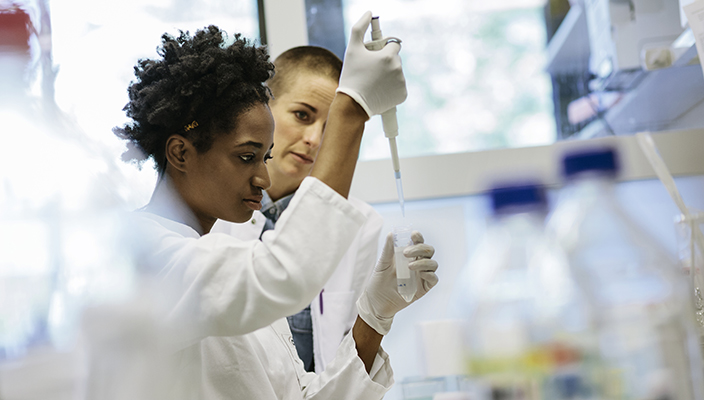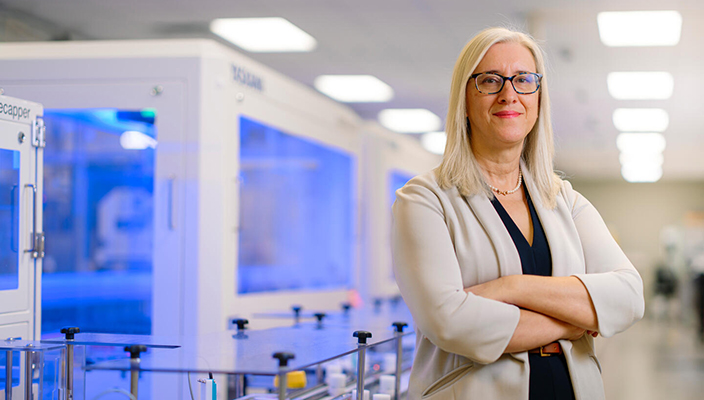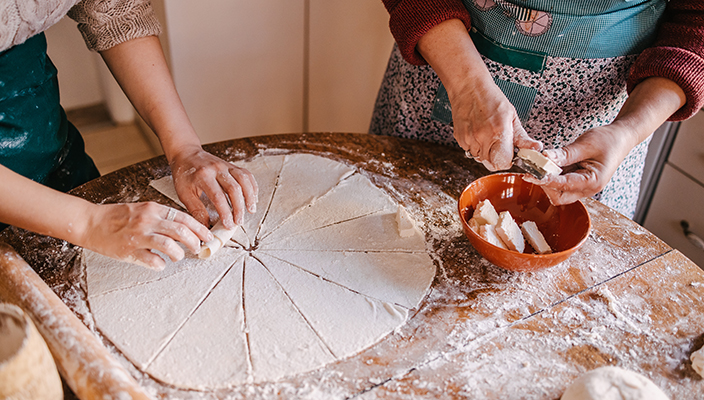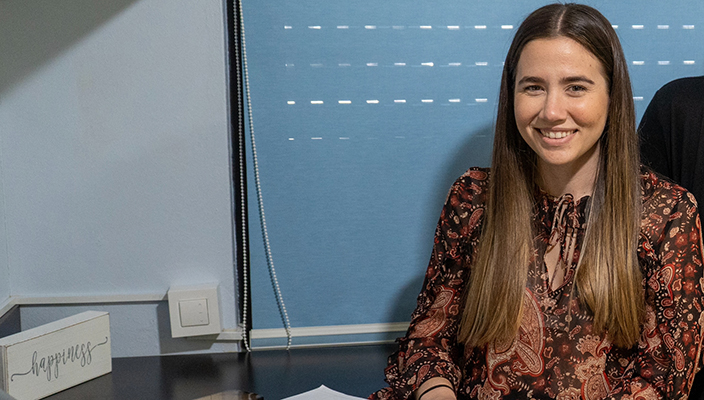Let’s say you participate in the All of Us Research Program. You were asked if you wanted to donate samples and said yes. So your blood and urine or saliva were collected.
But what happened after that? Where did those samples go? And what were they used for?
They go to a place called a biobank. That’s a storage facility where biological specimens are frozen and kept safe and ready for health research. Samples are important resources for many researchers. For researchers who study personalized medicine, they are essential.
Since 2016, the Biobank at Mayo Clinic has stored samples for the All of Us Research Program. Mayo’s main facility in Rochester, Minnesota, now has more than 10 million samples from All of Us participants. (About 2.3 million samples are stored in Mayo Clinic Florida, a backup facility in Jacksonville.) And more arrive every day.
Mine S. Cicek, Ph.D., is in charge of the Mayo Clinic Biorepositories Program. Dr. Cicek is a molecular cancer genetic epidemiologist. For years she studied genes involved in prostate, colon, and ovarian cancers. Then her job running the biobank became her main focus.
Samples are a key part of our research program. To learn what happens in the deep freezers of our biobank, we recently sat down with Dr. Cicek.
All of Us: What’s your background like? When did you arrive at the Mayo Clinic? And when did you start working with All of Us?
Mine Cicek: I'm from Istanbul, Turkey. I got my undergraduate degree in biology there, then came to the United States to do my master’s and Ph.D. at Virginia Tech. After I earned a doctorate in genetics, I went to Cleveland Clinic to study cancer biology. I did my postdoc there, and in 2005 came to Mayo Clinic to do a three-year fellowship. I stayed on as a researcher for the next 11 years, studying cancer.
Ten years ago, I became the director of the Biorepository Laboratory here at Mayo. Then two years ago, I was named head of the whole Biorepository Program. That means overseeing three labs—one here in Minnesota and two other sites. Mayo was awarded the All of Us biobank partnership in 2016, and that’s when we started receiving All of Us samples. So, I’ve been working with the research program since day one.
All of Us: What has that relationship been like? And what are some of the biggest changes you've seen over six years?
MC: Biorepository work has decades of history at Mayo, so this is not exactly new for us. We support hundreds of Mayo investigators and other investigators outside of Mayo.
But All of Us is by far the largest project we’ve ever worked with. Fortunately, it aligned really well for us as a larger-scale version of what we've been doing. We just had to scale everything way, way up. If we had one instrument of a kind, we got another dozen to meet the demand. And we’ve built upon our IT infrastructure, so we automate a lot of things.
We also partner with Mayo Medical Laboratories. It's a reference lab arm of the Mayo Clinic. It includes all 50 states and more than 300 couriers. That ensures the shortest transit time possible for specimens. Our goal is to get samples from the collection site to the biobank within 24 hours. And the optimal amount of time to do everything is 40 hours. That’s to collect a sample, transport it to the biobank, process it, and then store it in our freezer.
Which can be challenging. Let’s say a sample is collected in San Diego. All of Us partners there with a Federally Qualified Health Center called San Ysidro Health. The distance from that facility to Mayo in Rochester, Minnesota, is nearly 2,000 miles. Now think of all the things that could slow that journey. Bad weather. A problem with the plane engine, or maybe a flat tire on the ground transport. A missed connection by a courier. There’s a lot to plan and account for.
The good news is that most of the infrastructure was in place from the beginning. There are now 873 collection sites around the country. Many of them were already members of the Mayo Medical Lab when All of Us started. So, on day one we were ready to receive samples overnight in a very cost-effective way, then centrally process them here.
All of Us: How many All of Us samples are stored there now?
MC: Well, the program collects eight tubes from each participant who provides a blood sample. They give blood, urine, and, in some cases, saliva (not everyone donates all three samples). We receive samples from about 400 participants a day.
We process the samples from each participant, which is about 25 to 30 aliquots [portions of a larger sample]. One participant equals eight tubes total, divided into 30 aliquots. That total—which sums up to nearly 10,000—is how many samples a day we’re adding to our freezers right now.
Overall, we’ve received close to 2.8 million tubes. Right now, we have more than 10 million samples total. When All of Us reaches its 1 million cohort, we’re expecting to have nearly 30 million samples in our freezers available for research.
All of Us: How big is the biobank facility? How many people work there? And what are the storage protocols?
MC: In 2016, when we started, the space we used was 35,000 square feet. Today, we have a 100,000-square-foot facility for processing, storage, and distribution and almost 120 full-time employees, which is about twice the number we had eight years ago.
Some areas of the biobank are staffed 7 days a week to make sure the operation is functioning properly. We usually receive samples starting at 6 a.m. Our crew handles and processes all the specimens we receive, noting the time and day of receipt, putting everything into freezers, and making sure the samples stay frozen. We have metrics for the whole process.
The same is true for storage conditions. All blood, saliva, and urine samples are stored at -112 degrees Fahrenheit (-80 degrees Celsius). We also have a subset of whole blood derivatives. Those are stored at the same temperature as liquid nitrogen, which is below -238° F (-150° C).
All of Us: What are the biggest challenges of overseeing the biobank?
MC: The challenges come into play when there are deviations. Our main goals are no sample loss and preserving the quality and integrity of the samples. But if samples arrive really late or are damaged, then we can't process them. When that happens, we notify the collection site. Usually, we recommend that the participants return for a sample redraw.
Lots of samples arrive every day as well, from all over the nation. And we have to process all of them in real time. When you work with biospecimens, you can’t really say, “Oh, I'll do the rest tomorrow.” That’s not possible.
All of Us: What might readers be surprised to learn about the biobank?
MC: When I give tours, people are like, “You have hundreds and thousands of things coming in! And your samples don’t even have names on them—just barcodes. How do you know who's who or what's what?”
They don't know that we have a super sophisticated system. It’s almost all automated and hands-off. Each sample is coded in our database according to All of Us protocol. We put the collection tube into the automation, it registers that sample, processes it, and splits it up into smaller portions. Then we take each sample, put it in a box, and put it in the freezer.
Then, when I scan a barcode, the system tells me, “This sample was collected on June 24th of 2021. There is this much volume in this tube.” Everything we know about that individual’s sample. That's pretty amazing.
Personal information is very carefully protected. All samples are labeled with a number. That keeps identifiable information out of the system and safeguards a participant’s identity.
And we keep close tabs on where everything is. Every tube we receive and every aliquot we create is monitored. I know all 10 million samples we have and where they are in this enormous freezer. There is order to everything.
All of Us: Anything else you’d like to add as All of Us reaches its sixth anniversary?
MC: I would tell participants that no matter what project or program they’re involved with, they are the most important part. The participants come first.
And even though here in the biobank we don't get to see the participants, every single tube represents a person. That’s why we treat all the samples carefully—and equally. We understand how important each person’s participation is. We respect it and want to acknowledge it at every level. We want to support everyone who donates their time and samples to All of Us.
Because every participant matters to us. Everyone has value.
This interview has been edited and condensed for length and clarity.










